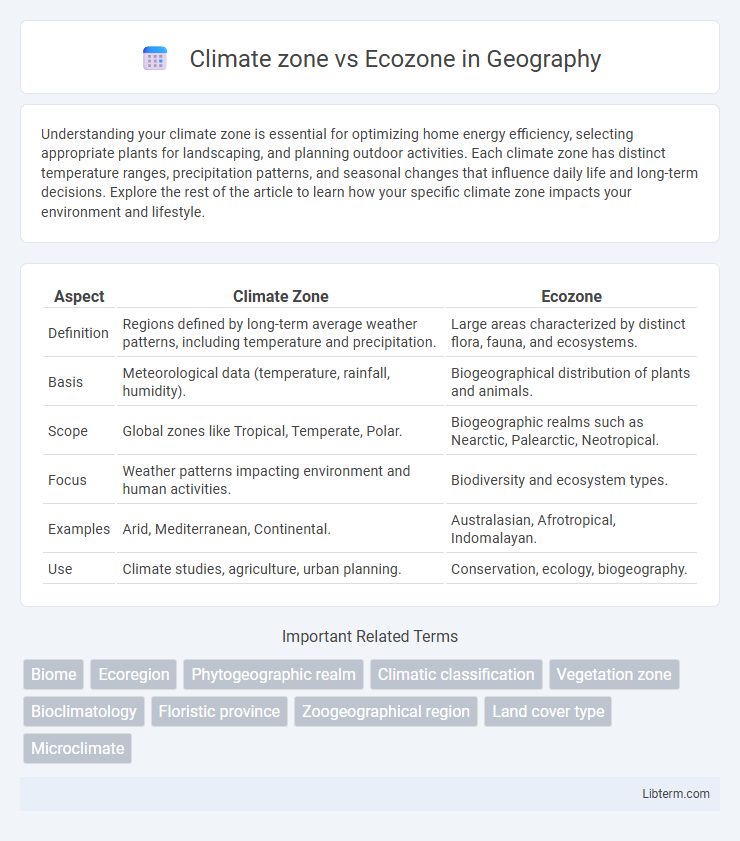Understanding your climate zone is essential for optimizing home energy efficiency, selecting appropriate plants for landscaping, and planning outdoor activities. Each climate zone has distinct temperature ranges, precipitation patterns, and seasonal changes that influence daily life and long-term decisions. Explore the rest of the article to learn how your specific climate zone impacts your environment and lifestyle.
Table of Comparison
| Aspect | Climate Zone | Ecozone |
|---|---|---|
| Definition | Regions defined by long-term average weather patterns, including temperature and precipitation. | Large areas characterized by distinct flora, fauna, and ecosystems. |
| Basis | Meteorological data (temperature, rainfall, humidity). | Biogeographical distribution of plants and animals. |
| Scope | Global zones like Tropical, Temperate, Polar. | Biogeographic realms such as Nearctic, Palearctic, Neotropical. |
| Focus | Weather patterns impacting environment and human activities. | Biodiversity and ecosystem types. |
| Examples | Arid, Mediterranean, Continental. | Australasian, Afrotropical, Indomalayan. |
| Use | Climate studies, agriculture, urban planning. | Conservation, ecology, biogeography. |
Understanding Climate Zones: Definition and Types
Climate zones categorize regions based on long-term temperature and precipitation patterns, such as tropical, temperate, arid, and polar zones, which influence local weather and ecosystems. These zones are defined by factors including latitude, altitude, and ocean currents, shaping the distinct climatic conditions experienced worldwide. Understanding climate zones helps distinguish them from ecozones, which are broader ecological regions based on biodiversity and habitat characteristics rather than just climate.
What Are Ecozones? Scope and Characteristics
Ecozones represent broad ecological regions defined by distinct assemblages of plant and animal species, climate conditions, soil types, and geological features, reflecting long-term evolutionary processes. Unlike climate zones that classify regions purely based on temperature and precipitation patterns, ecozones encompass a wider scope including biodiversity, ecosystem dynamics, and habitat types. These zones serve as crucial frameworks in conservation biology and environmental management, helping to preserve ecological integrity and guide sustainable natural resource use.
Key Differences Between Climate Zones and Ecozones
Climate zones classify regions based on temperature and precipitation patterns, determining weather conditions over time, while ecozones represent large areas characterized by distinct ecosystems and biodiversity influenced by both climate and geographical features. Climate zones are primarily defined by atmospheric conditions like humidity, temperature ranges, and rainfall, whereas ecozones consider biotic factors such as species composition, soil types, and ecological processes. The fundamental difference lies in climate zones addressing meteorological traits, whereas ecozones encompass broader ecological relationships integrating climate with living organisms and landscape attributes.
The Role of Geography in Determining Zones
Geography plays a critical role in differentiating climate zones and ecozones by influencing temperature, precipitation, and biodiversity patterns. Climate zones are primarily defined by atmospheric conditions such as latitude, altitude, and prevailing wind systems, resulting in classifications like tropical, temperate, and polar. Ecozones, also known as biogeographic realms, encompass broader ecological regions where geography shapes the distribution of flora, fauna, and ecosystems based on historical, geological, and climatic factors.
Climate Zones and Their Global Distribution
Climate zones classify Earth's surface into regions based on temperature, precipitation, and seasonal patterns, with major types including tropical, arid, temperate, polar, and mountainous zones. These zones are globally distributed, where tropical climates dominate near the equator, arid zones prevail around 30deg latitude, temperate zones cover mid-latitudes, and polar climates are found near the poles. Understanding climate zones is crucial for studying weather patterns, biodiversity, and human agricultural practices worldwide.
Ecozones: Biodiversity, Flora, and Fauna
Ecozones represent large geographic areas defined by distinct assemblages of flora, fauna, and ecosystems, reflecting unique biodiversity patterns shaped by evolutionary history and climatic conditions. Unlike climate zones that classify regions based on atmospheric parameters such as temperature and precipitation, ecozones emphasize biogeographical characteristics, encompassing various habitats from tropical rainforests to tundra landscapes. Rich biodiversity within ecozones supports specialized species adaptations and complex ecological interactions, making them critical for conservation efforts and understanding species distribution across the globe.
Climate Change Impact on Climate Zones
Climate zones, defined by long-term temperature and precipitation patterns, face significant shifts due to climate change, altering their geographic boundaries and seasonal characteristics. Ecozones, which represent regions with distinct ecological features and biodiversity, experience cascading effects as changing climate zones influence habitat distribution and species adaptation. These shifts lead to disruptions in ecosystem services, threatening biodiversity and increasing vulnerability within both natural and human systems.
Ecozone Shifts in Response to Environmental Changes
Ecozone shifts occur as species and habitats respond to environmental changes such as temperature fluctuations, altered precipitation patterns, and human activities, causing biomes to migrate or transform. These shifts affect biodiversity distribution, ecosystem services, and conservation strategies, requiring dynamic management approaches to protect vulnerable species and maintain ecological balance. Tracking ecozone changes provides critical insights into climate adaptation, habitat connectivity, and ecosystem resilience on a regional and global scale.
Mapping and Classifying Zones: Methods and Tools
Mapping and classifying climate zones rely heavily on meteorological data such as temperature and precipitation patterns, often visualized through GIS tools to delineate regions based on climate variables. Ecozone classification integrates biological, geological, and ecological factors using remote sensing technologies and biodiversity indices, facilitating spatial analysis of ecosystem boundaries. Advanced tools like satellite imagery, climate models, and vegetation mapping software enhance precision in both climate and ecozone delineation, supporting environmental planning and conservation efforts.
The Importance of Zones in Conservation Strategies
Climate zones, defined by temperature and precipitation patterns, directly influence habitat types and species distributions, making them crucial for understanding broad environmental conditions. Ecozones, encompassing distinct ecological communities and biodiversity based on geological and biological factors, provide a more detailed framework for conservation planning. Integrating both climate zones and ecozones enhances targeted strategies to preserve species diversity, ecosystem functions, and resilience against climate change impacts.
Climate zone Infographic

 libterm.com
libterm.com